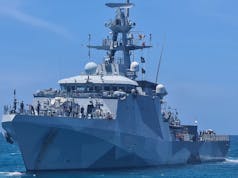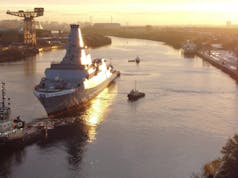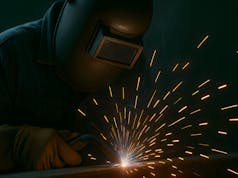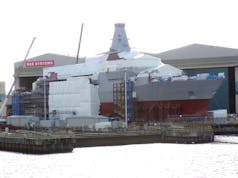GMB, the union for shipbuilders, has welcomed the Ministry Of Defence’s announcement of a contract to build the first batch of the Type 26 Frigate fleet.
The £3.7 billion deal will secure around 1,700 shipbuilding jobs in Scotland and 1,700 further jobs throughout across Britain until 2035.
Ross Murdoch GMB National Officer and interim CSEU Chair, said:
“It is fantastic news that the defence secretary has finally confirmed and signed the contract for the first batch of Type 26 Frigates.
Whilst we understand that it was always going to be announced in batches we look forward to future confirmation on the other five ships.
It is a particularly significant announcement in terms of the timing given the Queen Elizabeth Carrier going out from Rosyth last week to commence sea trials, as it once again reinforces the world class reputation of our UK shipyard workers. This is tremendous news for GMB members in Scotland in particular, but also in the wider context of the supply chain across the UK.”
Warships of this size and complexity are ordered in batches. The Type 45 Destroyer was ordered in batches, why should the Type 26 Frigate be any different?
As we predicted before the announcement that the first batch of Type 26 Frigates were ordered, some groups have taken the batch build process to indicate a cut. They’re wrong.
Ordering in batches is common for projects of this size around the world and was last seen with the Royal Navy for the Type 45 Destroyers and recent Offshore Patrol Vessels.
The Type 45s first batch order was for three vessels just like Type 26 and steel is to be cut on the first ship in Glasgow in the coming weeks.
Defence Secretary Sir Michael Fallon said:
“The Type 26 Frigate is a cutting-edge warship, combining the expertise of the British shipbuilding industry with the excellence of the Royal Navy. We will cut steel on the first ship later this month – a hugely significant milestone that delivers on our commitment to maintain our global naval power. These ships will be a force to be reckoned with, there to protect our powerful new carriers and helping keep British interests safe across the world.
“Backed by a rising defence budget and a £178bn Equipment Plan, the Type 26 programme will bring vast economic benefits to Scotland and the wider UK. The contract is structured to ensure value for taxpayers’ money and, importantly, now designed to protect them from extra bills from project overrun. The investment will secure hundreds of skilled jobs at BAE Systems on the Clyde for the next twenty years, and thousands of jobs in the supply chain across Britain.”
Commenting on this important announcement, Charles Woodburn, Chief Executive, BAE Systems said:
“The award of this contract is a strong endorsement of the talent and commitment of our employees across the UK and reinforces Glasgow as the centre of shipbuilding in the UK. We are extremely proud to be chosen to design and manufacture vessels that will give the Royal Navy an essential, next generation capability and be a vital addition to its fleet.
“We will continue to invest in our technologies, productivity and people to help us deliver these ships to the highest standards. Today we have five River Class Offshore Patrol vessels at varying stages of construction for the Royal Navy across our shipyards in Glasgow and we look forward to starting manufacture on the first Type 26 ship in the coming weeks.”
The UK Government committed to eight advanced anti-submarine warfare ships and “at least” five general purpose frigates in its 2015 Strategic Defence and Security Review (SDSR).
The Type 26 programme currently employs more than 1,200 people in the UK supply chain, with a number of contracts already in place for the manufacture of major equipment for the first three ships. In total, there are already 33 UK and international companies working in the supply chain to deliver the Type 26 ships – with further announcements to be made shortly.
It’s understood that the build plan for the Type 31 Frigate will follow a similar pattern to that of the Queen Elizabeth carriers and early Type 45 Destroyers in that blocks will be built in yards around the UK and assembled on the Clyde.
Additionally, it was recently announced recently that work had started on the fifth of five new Offshore Patrol Vessels being built on the Clyde.
It is understood that the yards on the Clyde will now build 18 vessels of varying types, instead of the originally promised 13.













Glad that an order has finally been placed but these frigates were supposed to be £400-600m each (benefitting from kit pull-through from the Type 23s to keep costs down) and now the contract is £3.7bn for 3 units. While the costs for the entire escort program (8x T26 plus 5x T31) is meant to come in at £8bn.
Perhaps this also includes equipment and services not directly related to the first three units, but the Departmental Minute is so carefully worded (“Type 26 Global Combat Ship Manufacture Phase 1 Contract, which will provide for the manufacture and testing of the first batch of Type 26 Global Combat Ships”) that the contract sounds like its £3.7bn for mfg and testing of the first batch. And not much else. Also remember that long lead items for the first ships were procured through an earlier, separate £859m contract. So I’m not sure what’s already paid for and what’s included in this new contract. MoD have been so opaque about accounting for unit costs.
I hope the Govt get round to incorporating Sir John Parker’s report into a new National Shipbuilding Strategy. His recommendation that the MoD set a capital procurement budget for each program at the start is a no brainer really, so you know how much money you have to play with at the outset and forces the MOD to lock down its requirements. Can’t believe it’s not been done currently; it’s rule no 1 of project management – set a budget. The endlessly iterative approach to MoD procurement of needs definition budgeting refine design new budget has resulted in huge cost escalations and unit reductions – e.g. 12 to 6 T45, and 13 to 8 T26.
Fantastic benefit until after they pull the plug after 6 are built.
At £1.2bn a piece, surely no one here thinks it will all go as planned?
Considering the price is over double what was originally talked about, building 6 would mean that the total cost would be roughly what the original 13 should have cost, so for Scotland they are the winner.
The question i would like to see asked in the commons is why the price is double the original forecasts, as the specs for the ships have pretty much remained the same and its not getting any new fancy weaponary for the price.
Just like the T45 project, twice the price for half as many.
The problem is not just the price leaving us strapped, but also ship numbers. We had 12 AAW destroyers (T42) and now the country has just 6 (T45). For Frigates it will be worse, probably 6 T26s instead of the original 16 T23s and 4 batch three T22s.
The world is just as big as its always been, it is getting more and more populous and some say more dangerous so less ships is wrong. It’s criminal how BAE and MOD have sucked our taxes and left us with so little. Obviously none of the 8000 staff at MoD Defence Equipment and Support procurement organisation in Abbey Wood, Bristol have noticed the problem. Just 0.75% of them for example would be enough for HMS Forth instead of using two MCMV crews. The pay of just 10 staff over 10 years would buy a Scan Eagle system of 4 units which would be far more useful.
https://ukdefencejournal.org.uk/minehunter-crew-transferred-hms-tyne-crew-brings-hms-forth-service/
https://ukdefencejournal.org.uk/hms-monmouth-conducts-sovereignty-patrol-off-gibraltar/
Just proves trade unions know sod all about economics.
Interestingly – Mr Fallon did not put this to parliament citing critical financial loss if it wasn’t signed promptly.
It has gone through an MOD governance and oversight committee though – so everything is above board…. !?!?!?!?
I think there are going to be questions asked in parliament
1) why no oversight allowed by parliament, what was the reason for no 14 day statutory oversight?
2) what were the financial penalties that meant HMG had to sign a rushed contract offering what appears to be terrible value for money? Were BAE actually putting HMG under undue pressure or did BAE have unlawful influence over this decision to order 3 frigates at this price?
3) Is the price for 3 ships at £3.7 billion correct or does this price include the initial missile order for mk41 vl system. If so what actual missile types and numbers ordered?
Fallon might be ok politically and totally squeaky clean but there are some interesting questions potentially to answer in front of the defence select committee. Who i fully intend to write too as a tax paying uk citizen and voter.
I’ve read the q&a form the defence committee, who either don’t know what they are talking about or don’t want to push the truth. The answers are always less than transparent and could be easily interpreted either way. A simple follow up question each time would clarify it but there doesn’t appear to be a will.
The great economic benefit is of course contingent that Scotland continues to be a part of the UK.
I suspect at this point it’s not. It would be too expensive to move the production away from Scotland, but the exit vote seems to be off the table for now.
SNP are a spent force. Thank god. More Scottish voters voted against them then for them. It is only our first past the post system that enabled the SNP to scrap through. Nearly 20 of their parliamentary seats were close to being lost and just sheer luck they were able to hold onto them.
I think the voters in Scotland are getting sick of the SNPs nationalistic rhetoric and want the SNP to concentrate on their day job. That of running a highly devolved and already almost independent nation. Which they are not doing very well at currently.
Back to defence matters, I hope the UK can see the type 26 programme through to completion of all 8 ships and hope that subsequent batches will be cheaper. There might be an issue of power plant, sensors, missiles and vertical launch silos that had to be ordered in bulk for the entire class. These costs might have had to be front loaded onto the initial 3 ship first batch. (i hope that is the case) but i am seriously worried it is not and therefore the RN will only end up with 6 vessels at this price.
Though ordering in batches lets the government cut numbers mid-project.
We need more of these. Plus all those missing Type 45s. My guess is we’ll end up with just six or eight 26s, and more 45s is as likely as a man on Mars by close of play on Friday this week.
…oh, and scrap the RAF to pay for a big scale-up of RN and RM forces.
Great investment im sure..we need more than 8 ..and 8 t31 s..
Im sick to death of hearing about this rising defence budjet and 178 billion pound equipment plan ..
The politicions talk a load of nonsense.thye want to start investing in defence properly not some cooked figures ..the marines have lost 200 .ive also read the army may be cut to 65000 its absolutely ridiculous ..this overseas aid budjet should absplutely be slashed in half and the defence budjet should be propped up with the other half..we cant keep giving vast sums of money away and then expect our service man and women to a hostile situation without being equipped and manned sufficiently its totally absurd..
WHen we get the eu shackles off and we return to a global Britain we will need to be resourced properly and in greater numbers..
The ridiculous point about cutting the numbers of Type 45s is that the big money was in the design, not the building. By cutting the numbers the cost per unit increased. Not a sound financial decision as well as a terrible defence decision. Are we seeing something similar here or do we see the next frigate design as a sound export venture as well as good for the Andrew? After all the Type 26 was supposed to meet these requirements.